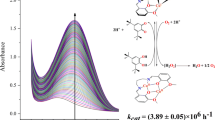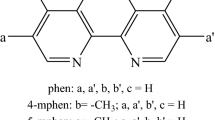Abstract
Covalent binding of 13 monocyclic aromatic amines to hemoglobin was studied in female Wistar rats and hemoglobin binding indices were determined. The hemoglobin adducts were hydrolyzed under alkaline conditions. In all cases the parent amine could be identified by gas chromatography and with one exception represented the only cleavage product. The binding index varied considerably and was highest withp-chloroaniline (569) and lowest with 2,4,5-trimethylaniline (0.7). Five compounds were also studied in female B6C3F1 mice. Hemoglobin binding was lower than in rats, but to varying degrees. Hemoglobin binding correlated remarkably well with the maximum methemoglobin level achieved with the six examples studied. The results support the notion that the reaction of nitrosoarenes, as metabolites of arylamines, with hemoglobin represents a general pathway in vivo. The analysis of such hemoglobin adducts is recommended as a dosimeter in biological monitoring of humans in order to control exposure. It is too early, however, to assess the carcinogenic risk from hemoglobin binding data with these compounds.
Similar content being viewed by others
References
Albrecht W, Neumann H-G (1985) Biomonitoring of aniline and nitrobenzene. Hemoglobin binding in rats and analysis of adducts. Arch Toxicol 57: 1–5
Bentley P, Bieri F, Muecke W, Waechter F, Stäubli W (1986) Species differences in the toxicity ofp-chloro-o-toluidine to rats and mice. Covalent binding to hepatic macromolecules and hepatic non-parenchymal cell DNA and an investigation of effects upon the incorporation of (3H)thymidine into capillary endothelial cells. Chem Biol Interact 57: 27–40
Birner G, Neumann H-G (1987) Biomonitoring of aromatic amines. Binding of substituted anilines to rat hemoglobin. Naunyn Schmiedeberg's Arch Pharmacol Suppl 335: R19
Büch H, Gerhards W, Karachristianidis G, Pfleger K, Rummel W. (1967) Hemmung der durch Phenacetin undp-Phenetidin verursachten Methämoglobin-Bildung durch Barbiturate. Biochem Pharmacol 16: 1575–1583
Dölle B, Töpner W, Neumann H-G (1980) Reaction of arylnitroso compounds with mercaptans. Xenobiotica 10: 527–536
Evelyn KA, Malloy HT (1938) Microdetermination of oxyhemoglobin, methemoglobin and sulfhemoglobin in a single sample of blood. J Biol Chem 126: 655–662
Eyer P (1979) Reactions of nitrosobenzene with reduced glutathione. Chem Biol Interact 24: 227–239
Groth U and Neumann H-G (1971/72) The relevance of chemicobiological interactions for the toxic and carcinogenic effects of aromatic amines V. The pharmacokinetics of related aromatic amines in blood. Chem Biol Interact 4: 409–419
Henschler D (edt.) Maximum Concentrations at the Workplace and Biological Tolerance Values for Working Materials 1987, Deutsche Forschungsgemeinschaft, Report No XXIII, VCH Verlagsgesellschaft mbH, Weinheim
Kiese M (1963) The effect of certain substituents upon the N-oxidation of aniline in vivo. Naunyn-Schmiedeberg's Arch Exp Pathol Pharmacol 244: 387–404
Lewalter J, Korallus U (1985) Blood protein conjugates and acetylation of aromatic amines. New findings on biological monitoring. Int Arch Occup Environ Health 56: 179–196
McLean S, Robinson J, Starmer GA, Thomas J (1967) The influence of anaesthetic agents on the formation of methaemoglobin induced by aniline in cats. J Pharm Pharmacol 19:803–809
McLean S, Starmer GA, Thomas J (1969) Methaemoglobin formation by aromatic amines. J Pharm Pharmacol 21:441–450
Neumann H-G (1984) Dosimetry and dose-response relationships. In: Berlin A, Draper M, Hemminki K, Vainio H (eds.) Monitoring human exposure in carcinogenic and mutagenic agents, IARC Scientific Publications No. 59, International Agency for Research on Cancer, Lyon, pp 115–126
Neumann H-G (1985) Die Rolle der Promotion bei der Einwirkung krebserzeugender Stoffe. In: Appel KE, Hildebrandt AG (eds.) Tumorpromotoren, bga-Schriften, MMV Medizin Verlag, München, pp 98–107
Neumann H-G (1987) Biomonitoring of aromatic amines and alkylating agents by measuring hemoglobin adducts. Int Arch Occup Environ Health (in press.)
Neumann H-G (1988) Initiation and promotion of liver lesions. In: King CM, Romano LJ, Schuetzle D (eds.), Carcinogenic and mutagenic responses to aromatic amines and nitroarenes. Elsevier Science Publishing Co., New York, Amsterdam, London, pp 241–247
Scott AI, Eccleston E (1967) Investigation of the general toxic and haematological effects of para-chloroaniline in several species. Proc Eur Soc Stud Drug Toxicity 8: 195–198
Skipper PL, Bryant MS, Tannenbaum SR (1988) Determination of human exposure to carcinogenic aromatic amines from hemoglobin adducts in selected population groups. In: King CM, Romano LJ, Schuetzle D (eds.) Carcinogenic and mutagenic responses to aromatic amines and nitroarenes. Elsevier Science Publishing Co., New York, Amsterdam, London, pp 65–71
Waynforth HB (1980) Experimental and surgical technique in the rat. Academic Press, London, New York, Toronto, Sydney, San Francisco
Weisburger EK (1983) Species differences in response to aromatic amines. Basic Life Sciences 24: 23–47
Wieland E, Neumann H-G (1978) Methemoglobin formation and binding to blood constituents as indicators for the formation, availability and reactivity of activated metabolites derived from trans-4-aminostilbene and related aromatic amines. Arch Toxicol 40: 17–35
Author information
Authors and Affiliations
Rights and permissions
About this article
Cite this article
Birner, G., Neumann, H.G. Biomonitoring of aromatic amines II: hemoglobin binding of some monocyclic aromatic amines. Arch Toxicol 62, 110–115 (1988). https://doi.org/10.1007/BF00570128
Received:
Accepted:
Issue Date:
DOI: https://doi.org/10.1007/BF00570128




